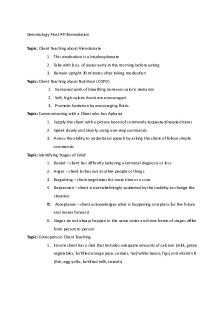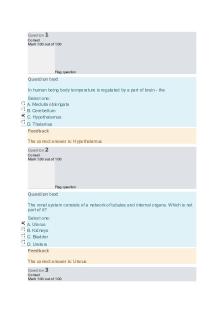Gerontology quiz 1 answers PDF

| Title | Gerontology quiz 1 answers |
|---|---|
| Author | Sarah Lubbock |
| Course | Maturing family |
| Institution | Baylor University |
| Pages | 5 |
| File Size | 125.7 KB |
| File Type | |
| Total Downloads | 67 |
| Total Views | 136 |
Summary
notes...
Description
LEARNING SYSTEM RN: Practice Quiz Gerontology 1. A nurse in a long-term care facility is promoting reminiscence among older adult clients. Which of the following actions should the nurse take? a. Institute a daily storytelling hour i. A storytelling hour is an example of reminiscence therapy, which allow clients to share stories of their past and reminisce with others who might have similar or shared memories. According to Erikson’s psychosocial theory, reminiscence is an important action for older adult clients. 2. A nurse in the clinic is assessing an older adult client for the second time in a week. The client reports a decreased energy level, insomnia, and anorexia. The client’s diagnostic tests are within the expected reference ranges. For which of the following conditions should the nurse screen the client? a. Depression i. Depression, an altered mood state characterized energy levels, insomnia, anorexia, and sadness is a common condition among older adult clients. Depression can be a response to an acute or chronic illness. Depression in older adult clients can also be the result of medications such as analgesics, antihypertensive, steroids, and cardiovascular agents. 3. A nurse is caring for an older adult client who has gout and refuses to eat. The client’s provider has approved the family to bring food from home. Which of the following foods should the nurse recommend that the client not eat? a. Lentil soup i. The client should eat purine-restricted diet to decrease the elevated uric acid levels. The diet is used for gout, renal calculi or both in conjunction with medication therapy. 4. A nurse in a long-term care facility is providing teaching to a group of adolescents who are new volunteers. The nurse should explain that older adult clients are most likely to exhibit a decrease in which of the following? a. Short-term memory i. The ability to process short-term memories decreases as part of the aging process. As a result, older adult clients might require reminders regarding their medications. ADLs, or daily schedules. The nurse should tell the volunteers that residents might have difficulty remembering their names from day to day, ask the same questions repeatedly or need assistance remembering recent events.
5. A nurse is teaching a group of healthy older adult clients about health screening after age 50 years. Which of the following health screenings should the nurse recommend that the clients complete annually? a. VISUAL ACUITY i. Screen for glaucoma 6. A nurse caring for a client who has Alzheimer’s disease and refuses to take her morning antihypertensive medication. The client is oriented to name and place and is able to perform ADLs with minimal supervision. Which of the following actions should the nurse take? a. Ask the client to express her reason for refusing the medication and document the event. 7. A nurse is assessing an older adult client for signs of dehydration. Which of the following findings should the nurse consider an expected part of the aging process? a. DECREASED CREATININE CLEARANCE i. Elevation of urine specific gravity I an unexpected finding that could be indicative of dehydration. 8. A nurse is providing discharge instructions about calcium supplements to an older adult female client who has osteoporosis and a recent repair of a fracture in her right hip. Which of the following instructions should the nurse include? a. “You should take your calcium supplement with a large glass of water” i. Taking calcium supplements with a large glass of water, with or after meals will promote absorption of the calcium. 9. A nurse is caring for an older adult client who has pneumonia. Which of the following physiologic changes associated with aging places the client at risk for pneumonia? a. DECREASED NUMBER OF CILIA i. Decreased number of cilia is a physiologic change with aging 10. A nurse is planning care for a client who had a stroke. Which of the following goals should the nurse identify as the priority for this client? a. The client’s airway will remain clear, as evidenced by clear breath sounds. 11. A nurse is conducting an admission assessment for an older adult client. Which of the following actions should the nurse take to collect subjective data? a. Allow sufficient time for the client to respond to the questions 12. A nurse is caring for an adult client. Which of the following physiologic changes associate with aging can affect medication dosage in this client?
a. Decreased gastric motility i. Medications would remain in digestive tract for longer periods of time, thus leading to slow absorption of medication 13. A nurse is caring for an older adult client who has a new onset of type 2 diabetes mellitus. Which of the following physiologic changes can contribute to the development of type 2 diabetes? a. Decreased sensitivity to the circulating insulin 14. A nurse at an assisted living center is conducting an orientation session for a group of newly hired assistive personnel. Which of the following instructions should the nurse include regarding clients who are hearing impaired? a. Maintain eye contact with the clients 15. A nurse is caring for an older adult client who has dementia. The client becomes agitated and confused at night and wanders into the hallway. Which of the following actions should the nurse take? a. Place the client’s mattress on the floor i. Ensure client safety and prevents falls 16. An older adult client tells a nurse at a health fair “I am always forgetting things. I cannot even remember where I parked my car! Do you think I have Alzheimer’s disease?” Which of the following is a therapeutic response by the nurse? a. “That must be very upsetting. Can you tell me about your forgetfulness?” 17. A nurse is participating on a committee that is developing age-appropriate care standards for older adult clients. Which of the following Erikson’s development tasks should the nurse recommend as the focus? a. INTEGRITY i. Integrity vs Despair 18. A nurse is planning to administer diphenhydramine hydrochloride to an older adult client. Which of the following actions should the nurse plan to take prior to administration? a. Review the medical record for a client history of glaucoma i. Diphenhydramine is contraindicated for narrow-angle glaucoma – diphenhydramine dilates pupils and glaucoma medications constrict pupils for the circulation of aqueous humor 19. A nurse is developing a plan of care for a client who had a recent stroke and has a history of gastroesophageal reflux (GERD). For which of the following disorders should the nurse plan to monitor this client?
a. Aspiration pneumonia 20. A nurse at an ophthalmology clinic is assessing a client referred by the provider for a potential cataract. Which of the following client reports should the nurse recognize is consistent with cataracts? a. Halos when looking at lights 21. A nurse is teaching a newly hired assistive personnel about her role in helping older adult clients with activities of daily living. The nurse should explain that which of the following is the most common factor that affects a client’s performance of ADLs? a. Chronic physical disability 22. A nurse is teaching a group of older adult female clients who are postmenopausal about dietary requirements. Which of the following statements about the role of folic acid should the nurse make? a. “Adequate folic acid intake is associated with a reduced risk for heart disease i. RDI for postmenopausal clients – 400 mcg, lowers homocysteine, which is a risk factor for heart disease. 23. A home health nurse is visiting an older adult client who has anemia. Which of the following foods should the nurse recommend to increase the client’s iron intake? a. Dried fruit 24. A nurse is teaching an older adult client who is on bedrest following development of deep vein thrombosis about methods to increase peristalsis. Which of the following high-fiber food choices should the nurse recommend? a. Navy bean soup 25. A nurse is assessing an older adult client during an annual physical. Which of the following client findings should the nurse report to the provider? a. Fasting Blood glucose level of 160 mg/dL 26. A nurse reviewing he medical record of a client who is postmenopausal and has osteoporosis. The client has a new prescription for alendronate sodium. Which of the following findings in the client’s history should the nurse recognize is a contraindication to this medication? a. ESOPHAGEAL ACHALASIA i. Alendronate sodium is a bisphosphonate, which prevents or slows weakening of bones. Wait 30 minutes after taking medication to eat. 27. A nurse is planning care for an older adult client following abdominal surgery for a bowel obstruction. Which of the following information about pain management should the nurse consider when planning care?
a. Older adult clients are sensitive to the analgesic effect of opiates 28. A nurse is providing teaching to an older adult client who has osteoarthritis of the right hip and lower lumbar vertebrae which of the following statements by the client indicates an understanding of the teaching? a. To relieve the pressure of my hip, I can use a cane while ambulating 29. A nurse is assessing an older adult client who states he is homeless. Which of the following findings should the nurse document as comorbidities for this client? a. Dementia and tuberculosis 30. A nurse admitting an older adult client who fell at home 3 days ago. The client has a fractured hip, malnutrition, and dehydration. Which of the following laboratory values noted on admission, should indicate to the nurse prolonged malnutrition? a. Decreases albumin...
Similar Free PDFs

Gerontology quiz 1 answers
- 5 Pages

ATI Gerontology Exam 1
- 27 Pages

Gerontology ATI Remediation 1
- 2 Pages

HRM 200 Quiz 1 - Quiz 1 Answers
- 11 Pages

Quiz 1 questions + answers
- 4 Pages

Quiz 1, answers
- 6 Pages

QUIZ#1 KEY Answers
- 3 Pages

Terminology Quiz 1 answers
- 3 Pages

Module 1 Quiz answers
- 5 Pages

Module 1 Quiz Answers
- 1 Pages

Chapter 1 Quiz answers
- 7 Pages

Chapter 1 Quiz & Answers
- 4 Pages

Quiz 1 answers
- 5 Pages

Possible quiz 1 answers
- 2 Pages

Quiz 1 2017, answers
- 35 Pages
Popular Institutions
- Tinajero National High School - Annex
- Politeknik Caltex Riau
- Yokohama City University
- SGT University
- University of Al-Qadisiyah
- Divine Word College of Vigan
- Techniek College Rotterdam
- Universidade de Santiago
- Universiti Teknologi MARA Cawangan Johor Kampus Pasir Gudang
- Poltekkes Kemenkes Yogyakarta
- Baguio City National High School
- Colegio san marcos
- preparatoria uno
- Centro de Bachillerato Tecnológico Industrial y de Servicios No. 107
- Dalian Maritime University
- Quang Trung Secondary School
- Colegio Tecnológico en Informática
- Corporación Regional de Educación Superior
- Grupo CEDVA
- Dar Al Uloom University
- Centro de Estudios Preuniversitarios de la Universidad Nacional de Ingeniería
- 上智大学
- Aakash International School, Nuna Majara
- San Felipe Neri Catholic School
- Kang Chiao International School - New Taipei City
- Misamis Occidental National High School
- Institución Educativa Escuela Normal Juan Ladrilleros
- Kolehiyo ng Pantukan
- Batanes State College
- Instituto Continental
- Sekolah Menengah Kejuruan Kesehatan Kaltara (Tarakan)
- Colegio de La Inmaculada Concepcion - Cebu
